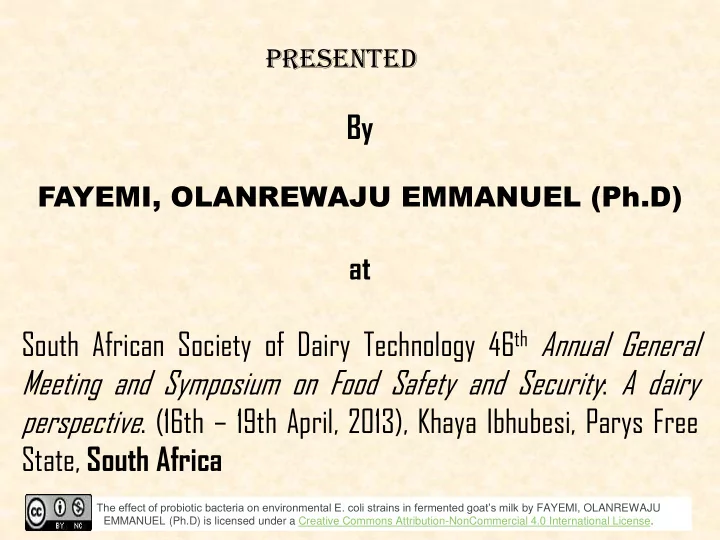

Presented By FAYEMI, OLANREWAJU EMMANUEL (Ph.D) at South African Society of Dairy Technology 46 th Annual General Meeting and Symposium on Food Safety and Security : A dairy perspective . (16th – 19th April, 2013), Khaya Ibhubesi, Parys Free State, South Africa The effect of probiotic bacteria on environmental E. coli strains in fermented goat’s milk by FAYEMI, OLANREWAJU EMMANUEL (Ph.D) is licensed under a Creative Commons Attribution-NonCommercial 4.0 International License.
The effect of probiotic bacteria on environmental E. coli strains in fermented goat’s milk - FAYEMI, O. E (Ph.D)
Introduction • E. coli strains are non-pathogenic members of the intestinal microbiota of humans and other animals, but some acquired virulence factors that enable them to cause important intestinal and extra intestinal diseases, such as diarrhoea, hemorrhagic colitis (HC), and haemolytic uremic syndrome (HUS) • Diarrhoea disease is a major cause of morbidity and mortality in children aged five and below in most low-and- middle income countries (Olatunde et al. 2011)
• In 2009, UNICEF and WHO reported that one in five child deaths (about 1.5 million) each year is due to diarrhoea. It kills more young children than AIDS, malaria and measles combined • According to Carey et al . (2008), the majority of the outbreaks of diarrhoea are associated with water and food. • In many rural areas of South Africa, village communities depend on untreated water from wells, rivers, and other surface-water for drinking and food processing (Pascal, 2009)
Acid Resistance in E. coli • Acidification is a treatment commonly used to control growth or kill pathogenic microorganisms in foods • Implication of fermented foods in food-borne outbreaks caused by E. coli. • Several studies have been done to determine the mechanism of acid – adaptation and acid resistance in E. coli systems (Dlamini and Buys, 2009 )
Problem Statement • Eli Metchnikoff hypothesis • If the extended survival of E. coli in acidic foods cannot be dismissed, then What will be the effects of probiotic bacteria on the growth of E. coli in fermented goat’s milk product?
Why goat’s milk ? • The lower buffering capacity of goat’s milk when compared with that of cow milk may allow for a faster acidification of that media, thus avoiding contamination during fermentation during fermentation undertaken with species that grow slowly such as common probiotic.
Aim This work was undertaken to study the survival of acid adapted and Non adapted E. coli strains in the goat’s milk fermented with starter cultures and probiotic bacteria.
Methodology Acid Adaptation procedure Raw goat’s milk Environmental E. coli strains Induction of acid Addition of Skim milk (3%) resistance in TS broth at and Gelatine (0.5%) pH 4.5 Pasteurization Incubation at 37 0 C for 18h Inoculation with L. plantarum Centrifugation (B411) and starter culture ( L. bulgaricus and S. thermophilus) DEPENDENT VARIABLES Acid adapted E. coli strains Fermentation at 30 0 C for 6 hours Viability on Analyses selective agar Inoculation with acid adapted and Microbial Non-adapted E. coli strains when growth/counts the pH is at 4.5 pH (pH meter) TTA Analyses at 2h interval Fermented goat’s milk
Results 10 9 8 Log 10 counts (cfu/ml) 7 Growth at pH 4.5 Growth at pH 7.4 6 5 4 Survival of environmental E .coli in TS Broth at pH 4.5
6.2 6 5.8 5.6 5.4 5.2 pH 5 4.8 4.6 4.4 4.2 4 0 2 4 6 Time (hours) starter + Probiotic + NA E.coli probiotic + AA E. coli starter + AA E.coli starter + NA E.coli starter + Probiotic + AA E.coli Probiotic + NA E. coli GOAT’S CHANGES IN THE PH DURING THE FERMENTATION OF MILK
1.1 0.9 SPNA PAA SAA TTA SNA 0.7 SPAA PNA 0.5 0.3 0.1 0 2 4 6 Time (hours) GOAT’S CHANGES IN THE TITRATABLE ACIDITY DURING THE FERMENTATION OF MILK.
Acid adapted Non acid adapted 9.5 9.5 9 9 Log 10 counts (cfu/ml) Log 10 counts (cfu/ml) 8.5 8.5 8 8 7.5 7.5 0 2 4 6 0 2 4 6 Time (hours) Time (hours) starter + probiotic starter Probiotic GROWTH OF STARTER CULTURES AND L. PLANTARUM (B411) DURING THE FERMENTATION OF GOAT’S MILK
Non acid adapted Acid adapted 7.5 7.5 7 7 6.5 6.5 log 10 counts(cfu/ml) log 10 counts(cfu/ml) 6 6 5.5 5.5 5 5 4.5 4.5 4 4 0 2 4 6 0 2 4 6 Time (hours) Time (hours) sta tart rter starter + probiotic Probiotic SURVIVAL OF ACID ADAPTED (AA) AND NON ADAPTED E COLI DURING THE FERMENTATION OF GOAT’S MILK
Conclusions The preliminary results from this study indicate that: • Fermentation of the goat’s milk with a single strain of L. plantarum does not ensure the safety of the product as it allows the survival of both acid adapted and non-adapted toxigenic E. coli strains; • Inhibition of acid adapted E. coli strains can be achieved in fermented goat’s milk through fermentation of the product with the combination of starter cultures ( L. bulgaricus and S. thermophilus ) and L. plantarum ;
Thank you for listening The effect of probiotic bacteria on environmental E. coli strains in fermented goat’s milk by FAYEMI, OLANREWAJU EMMANUEL (Ph.D) is licensed under a Creative Commons Attribution-NonCommercial 4.0 International License.
Recommend
More recommend